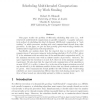21 search results - page 1 / 5 » A Tighter Analysis of Work Stealing |
ISAAC
2010
Springer
13 years 2 months ago
2010
Springer
Abstract. Classical list scheduling is a very popular and efficient technique for scheduling jobs in parallel platforms. However, with the increasing number of processors, the cost...
SC
2009
ACM
13 years 11 months ago
2009
ACM
Irregular and dynamic parallel applications pose significant challenges to achieving scalable performance on large-scale multicore clusters. These applications often require ongo...
EUROPAR
2010
Springer
13 years 5 months ago
2010
Springer
Abstract. We study the problem of dynamic load-balancing on hierarchical platforms. In particular, we consider applications involving heavy communications on a distributed platform...
FOCS
1994
IEEE
13 years 8 months ago
1994
IEEE
This paper studies the problem of e ciently scheduling fully strict (i.e., wellstructured) multithreaded computations on parallel computers. A popular and practical method of sche...
COMPGEOM
2008
ACM
13 years 6 months ago
2008
ACM
The Johnson-Lindenstrauss random projection lemma gives a simple way to reduce the dimensionality of a set of points while approximately preserving their pairwise distances. The m...

